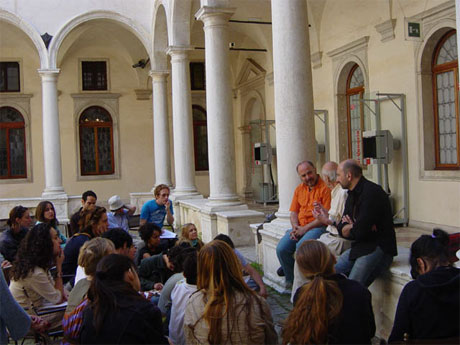In the project I realized last June for Domus Academy in an old monastery where the Italian phone company Telecom has a base, the problem was to create a space were it would be possible to produce a kind of energetic field for contemporary art and architecture in an international town like Venice during the Visual Arts Biennale. The idea was to put together artists and architects to create a space for creativity and discussion on the idea of models in art and architecture. I invited artists like Olafur Eliasson, Warren Neidich, architects like Yona Plug-In Space Friedman, Kjetil Thorsen, some curators like Hans Ulrich Obrist, Hou Hanru, Massimiliano Gioni and the editor of Domus magazine, Stefano Boeri, to create a complex project in which to produce new ideas, art projects, images, reflections and events. I tried to merge art and architecture in a unique field, inviting artists and architects who normally work in a cross-border area, where the distinction between these two fields are blurred. It became evident as the project developed that ‘model’ wasn’t an abstract idea for art, but a way for producing a new model for contemporary reality, a new kind of approach by artists to reality. And the title of this project was chosen by Eliasson as “Modelmania”.
The idea of the model was a way for artists and architects to deal with reality, so I tried to think space of art as social space, and vice versa. The question of the international perspective on art today is set against the background of globalisation. So, the second question was: how to think a space for art in the general context of globalisation? The idea was to produce a multi-layered space in which different events and moments of aggregation, production and discussion could be developed. A kind of palimpsest in which events and projects could be put together in an interchangeable way: a Plug-In Space. Thinking of art space as social space means also to put on the same plane events, works, projects and discussions; because any single gesture for art has a concrete will to act on reality. So, the important thing was not the final object as work of art, but the process of producing it. So the idea of a Plug-In Space is a proposal for interpreting art as process against the background of globalisation.
Starting from these considerations, the practical realization of a Venetian Plug-In Space was realized by creating different situations at different levels, starting with a laboratory with some young artists, architects and curators in a workshop with Olafur Eliasson and others artists and architects. One of the key concepts that came out of this discussion was Eliasson’s idea of a “re-negotiation” of the contemporary idea of space. A strong example of that was his own “The Weather Project” for Tate Modern. During the workshop, participants tried to use the “Endless Study” by Eliasson: a machine for drawing models.
A second level of the Plug-in Space was Yona Friedman’s project, titled “Merzstrukturen”, a small construction realized with poor material - cardboard - which was half a shelter and half a “Merzbau”, shown in one of the cloisters which was the base of the entire project. This introduced in the Venetian urban space the housing dimension of a shantytown, creating a very interesting a stimulating relationship. As in the shantytown, the construction is a shelter for protecting people from the sun, but at the same time realized with simple gestures that combine strategies for surviving with a primary aesthetic production.
Another level again was the public panel discussion on the social space as a space and material for artistic production, which involved artists, architects and critics like Massimiliano Gioni and Stefano Boeri. Finally, the fourth level was the final night event, also open to the public, in which Olafur Eliasson and Yona Friedman - helped by Hans Ulrich Obrist - described their own way to think at work, showing part of their process of production. In this part of the project the Plug-In Space was filled with people living in Venice or coming for the Biennale. So, the multi-layered situation created for this project could be modified by means of its plug-in structure, in which it is possible to add or take away events or projects. The final aim was to create the conditions of a “process situation” in which it was possible to activate an inside situation, with a lot of energy between participants, and an outside situation producing a relationship with the real context of the town and with the people living there at that particular time.
Maurizio Bortolotti
Curator of the Domus Academy Art Experience Project
